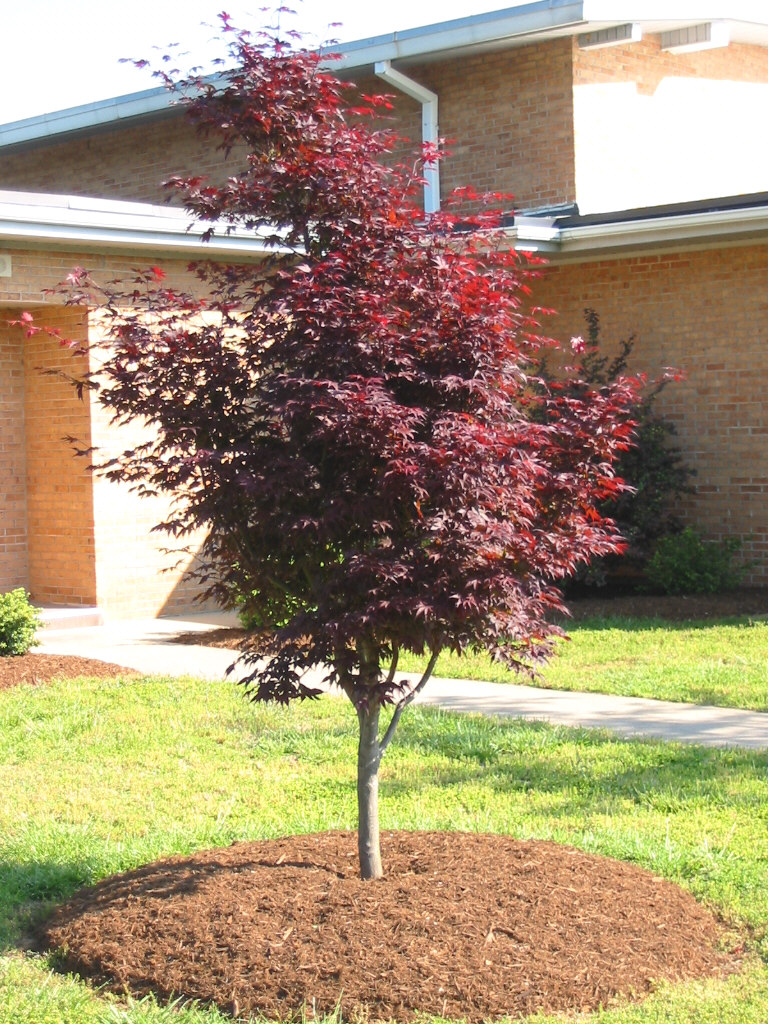The Bloodgood Japanese Maple Tree
The Plant Type:
These exquisite plants are classified as deciduous trees. Some Bloodgoods are produced by grafting.
Attributes of Bloodgood Japanese Maple Trees:
This widely grown tree may reach a height of 15 feet (with a similar spread) at maturity but is a very slow
grower. The spring leaves on mine give me as much pleasure as the leaves of any other season: during this period, the red in the foliage is sometimes at its brightest (in my landscape). The color becomes darker in summer — more of a burgundy, or even darker. Indeed, atropurpureummeans “dark purple,” from the Latin atro, “black” and purpureum, “purple.”
The palmatum in the Latin name is also descriptive of the leaf. Foliage said to be “palmate” bears lobes that fan out from a central point. The allusion is to the human hand, where fingers radiate out from the palm.
This foliage is displayed in a rounded canopy comprising a branching pattern that is very attractive in its own right. Rather than having a single leader, the plant will often have multiple sub-trunks. When samaras develop, they eventually redden and add some ornamental value to the plant.
Growing Zones:
This colorful character is best suited for growing zones 5-8.
Sun and Soil Requirements:
Dappled shade is considered the ideal exposure in most regions for this shade ornamental anchor tree. Mine gets a bit more shade than that and does just fine. In hotter climates a somewhat shady location could help you avert disaster with these plants. The leaves tend to develop some green in them in summer if exposed to more sun. A soil that drains well is essential, as it is for so many plants and trees in these planting zones.
Uses in Landscaping:
Most people use them as specimen trees, although they are also used in bonsai and focal points. Relatively compact while still filling enough space to be showy, they help you strike just the right balance size-wise for landscaping in small spaces. That’s why I’ve termed Acer palmatum atropurpureum ‘Bloodgood’ your “Ace(r) in the hole” for small yards or small courtyard type spaces. Use them, for example, as shade trees for patios (where a larger specimen would not be suitable).
Undoubtedly, leaf color is the salient trait of this species. But this coloration is supplemented by other features that earn Bloodgood Japanese maples their valued specimen status.
First of all, the leaves are elegantly shaped. Secondly, the branching pattern will be showy enough to afford winter interest, assuming you’ve administered any corrective pruning that may be necessary (see below under Care).
Leaf Shape: Going to Pot?:
Varieties of Japanese maples are sometimes loosely grouped by the appearance of their leaves. These categories can be based on color or on shape. A variety such as Crimson Queen is referred to as “dissected” because its leaves bear an especially lacy shape, with deep indentations along the leaf margins. If you’re seeking the finest possible texture, it’s a dissected type that you’d want to grow.
Bloodgood Japanese maples are a non-dissected type. But that doesn’t mean that their leaf shape won’t draw attention. Many liken the leaf shape to that on a marijuana plant. In fact, folks have come under suspicion of growing marijuana when, in fact, they were guilty of no more than growing Japanese maples. The most infamous case is that of Ryan David Frederick, who was a resident of Chesapeake, Virginia. Based on the mistaken report of an informant that Frederick was growing pot, police raided his home on the night of January 17, 2008. In the confusion that ensued, one of the officers was killed. If the informant had taken some horticulture classes, this tragedy could probably have been avoided.
So Do You Grow Bloodgood Japanese Maple Trees for Fall Color?:
I would answer this question with a yes, but with a qualification. Let me explain:
Although their leaves can become even showier in autumn than in summer (reverting back sometimes to the crimson color exhibited in spring) if the growing conditions are correct, I don’t consider Bloodgood Japanese maples to be first and foremost fall-foliage specimens. Nay, to classify them in that way would be an injustice. Their leaves are attractive for a full three seasons of the year, so I would classify them simply as “foliage trees” rather than limiting their value by designating them fall-foliage specimens, specifically. Their fall color can be excellent, but I regard it as part of the bigger package.
Care for Bloodgood Japanese Maple Trees (Pruning, Etc.):
Care requirements are minimal. You can prune young plants to encourage a particular branching pattern. As they mature, pruning (to the extent that it is needed at all) can be reduced to removing branches that are rubbing against each other (and, as for all plants, dead branches).
Other than this light pruning, the main care tasks for established plants will be supplemental watering (as needed) and the application of mulch. The latter will aid the soil in retaining moisture. Remember, these are slow growers so any aggressive pruning can be removing several years of growth! Until next time…Happy Gardening!!
Jimmie

